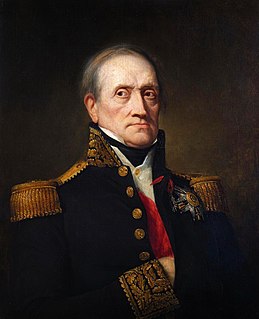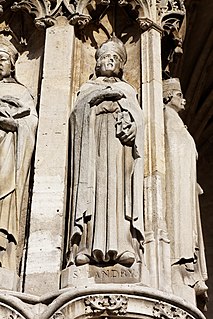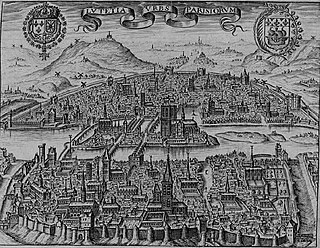This article needs additional citations for verification .(September 2013) |
The Filles-Dieu ("daughters of God") were a French religious congregation founded before 1270, which was devoted to the service of the sick.
This article needs additional citations for verification .(September 2013) |
The Filles-Dieu ("daughters of God") were a French religious congregation founded before 1270, which was devoted to the service of the sick.
Briefly known as Sisters of Saint-Gervais, since they were employed in the hospital of the same name in 1300.[ citation needed ] Their branches were mainly in Paris, Orléans, Beauvais and Abbeville.[ citation needed ] At the end of the 15th century the Paris house was on the Rue Saint-Denis, just a few metres from the Porte Saint-Denis, and was a home for two hundred ex-prostitutes. [1] The Filles-Dieu wore a white robe and a black coat.[ citation needed ]

The Catacombs of Paris are underground ossuaries in Paris, France, which hold the remains of more than six million people in a small part of a tunnel network built to consolidate Paris' ancient stone quarries. Extending south from the Barrière d'Enfer former city gate, this ossuary was created as part of the effort to eliminate the city's overflowing cemeteries. Preparation work began shortly after a 1774 series of Saint Innocents-cemetery-quarter basement wall collapses added a sense of urgency to the cemetery-eliminating measure, and from 1786, nightly processions of covered wagons transferred remains from most of Paris' cemeteries to a mine shaft opened near the Rue de la Tombe-Issoire.

The Basilica of Saint-Denis is a large former medieval abbey church and present cathedral in the city of Saint-Denis, a northern suburb of Paris. The building is of singular importance historically and architecturally as its choir, completed in 1144, is widely considered the first structure to employ all of the elements of Gothic architecture.

Charles VI, nicknamed the Beloved and later the Mad, was King of France from 1380 until his death in 1422. He is known for his mental illness and psychotic episodes which plagued him throughout his life.

Marshal General Jean-de-Dieu Soult, 1st Duke of Dalmatia, was a French general and statesman, named Marshal of the Empire in 1804 and often called Marshal Soult. Soult was one of only six officers in French history to receive the distinction of Marshal General of France. The Duke also served three times as President of the Council of Ministers, or Prime Minister of France.

Abbé Pierre, OFM Cap, was a French Catholic priest, member of the Resistance during World War II, and deputy of the Popular Republican Movement (MRP). Abbé is a courtesy title given to Catholic priests in French-speaking countries.

Leo V or Levon V, of the House of Lusignan, was the last Latin king of the Armenian Kingdom of Cilicia. He ruled from 1374 to 1375.

The siege of Rouen was a major event in the Hundred Years' War, where English forces loyal to Henry V captured Rouen, the capital of Normandy, from the Norman French.

The Hôtel-Dieu is a hospital located on the Île de la Cité in the 4th arrondissement of Paris, on the parvis of Notre-Dame. It was supposedly founded by Saint Landry in 651 AD, making it the oldest hospital in the city and the oldest worldwide still operating. The Hôtel-Dieu was the only hospital in the city until the Renaissance. While the old Hôtel-Dieu stood by the Seine on the opposite side of the parvise, it was ravaged by fire several times, and was rebuilt for the last time at its present location between 1867 and 1878, as part of Haussmann's renovation of Paris.

Marseille-Saint-Charles is the main railway station and intercity bus station of Marseille, France. It is the southern terminus of the Paris–Marseille railway and western terminus of the Marseille–Ventimiglia railway.

Marie-Dominique Chenu was a progressive Catholic theologian and one of the founders of the reformist journal Concilium.

Roustam Raza, also known as Roustan or Rustam, was a mamluk bodyguard and secondary valet of Napoleon.

Saint Landry (Landericus) of Paris was a bishop of Paris and is recognized as a saint by the Roman Catholic Church. Landry built a hospital dedicated to St. Christopher, which later became the Hôtel-Dieu de Paris. His feast day is 10 June.

The wall of Charles V, built from 1356 to 1383 is one of the city walls of Paris. It was built on the right bank of the river Seine outside the wall of Philippe Auguste. In the 1640s, the western part of the wall of Charles V was demolished and replaced by the larger Louis XIII wall, with the demolished material reused for the new wall. This new enclosure (enceinte) was completely destroyed in the 1670s and was replaced by the Grands Boulevards.

Saint-Denis is a commune in the northern suburbs of Paris, France. It is located 9.4 km (5.8 mi) from the centre of Paris. Saint-Denis, which had a population of 112,091 as of 2018, is a subprefecture of the department of Seine-Saint-Denis, being the seat of the arrondissement of Saint-Denis.

In the 10th century Paris was a provincial cathedral city of little political or economic significance, but under the kings of the Capetian dynasty who ruled France between 987 and 1328, it developed into an important commercial and religious center and the seat of the royal administration of the country. The Île de la Cité became the site of the royal palace and the new cathedral of Notre-Dame, begun in 1163. The Left Bank was occupied by important monasteries, including the Abbey of Saint-Germain-des-Prés and the Abbey of St Genevieve. In the late 1100s, the collection of colleges on the left bank became one of the leading universities in Europe. The Right Bank, where the ports, central markets, artisans and merchants were located, became the commercial center of the city, and the merchants assumed an important role in running the city. Paris became a center for the creation of illuminated manuscripts and the birthplace of Gothic architecture. Despite civil wars, the plague, and foreign occupation, Paris became the most populous city in the Western world during the Middle Ages.
Holigost was a carrack of the English navy rebuilt for Henry V. Originally a Castillian vessel called Santa Clara, she was captured c.1413–14. She served until 1422 and later sank at her moorings. Her wreck is believed to have been found in the River Hamble, Hampshire, near the wreck of her larger contemporary, the Grace Dieu. The wreck is a Protected Wreck managed by Historic England.

The 2015 Saint-Denis raid was a police raid which became a shootout between at least one hundred French police and soldiers and suspected members of the Islamic State of Iraq and the Levant in the Paris suburb of Saint-Denis.

The name Concert Mayol refers to a former cabaret situated at 10 rue de l'Échiquier in the 10th arrondissement of Paris.

Princess Marie-Louise Razafinkeriefo of Madagascar was the last heir apparent and pretender to the throne of the Kingdom of Madagascar. She was a grandniece, and the adoptive daughter, of Ranavalona III. During World War II, she worked as a nurse and was made a Dame of the National Order of the Legion of Honour by the French government for her medical service.

The scepter of Charles V, also known in the early modern period as scepter of Charlemagne, is one of the most prominent preserved regalia of the Kingdom of France. It was donated by Charles V to the abbey of Saint-Denis on 7 May 1380, shortly before his death. It has been used since for the coronation (sacre) of nearly all monarchs of France until Charles X, only excepting Charles VII and Henri IV. It has been kept at the Louvre since 5 December 1793.